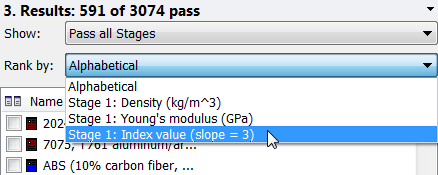About index lines and performance indices
Index lines and performance indices are a key element of the materials selection methodology that GRANTA EduPack is based on, pioneered by Prof. Mike Ashby at the University of Cambridge. They enable you to quickly identify optimal materials for an application.
About index lines and performance indices
A performance index is a ratio of material parameters to optimize in order to maximize the performance of a component, based on the specific function, limiting constraint, and objective of the design. Index lines can be used on a chart to compare the performance index value of different materials.
A performance index is defined by four design factors:
- The function is the basic geometry and load condition of the design (e.g. a panel loaded in bending).
- The limiting constraint is the main criterion to be met for the component to avoid failure (e.g. a stiffness-limited design, where a panel fails if it bends too far under an applied load).
- The objective is the main variable to optimize (e.g. minimize mass or cost).
- The free variable is the geometry parameter that is free to vary with material choice (e.g. the thickness of a panel). Note that if there is no free variable (i.e. it is a fixed design geometry), then you need to use a different methodology that applies to fixed geometry designs.
Each combination of function, limiting constraint, objective, and free variable has a characteristic performance index. For example, a light (objective), stiff (limiting constraint), panel loaded in bending (function), with thickness as the free variable, has a performance index of E1/3/ρ, where E=Young’s modulus (limiting constraint for stiffness) and ρ=density (objective for minimizing mass).
By convention, materials with the highest value of the performance index will be optimal for the design.
Index lines can be used to compare the performance of different materials, and to find replacement materials. Materials that are on the line will all perform equally well in a given design. Materials above the line have a higher performance index and will therefore perform better; those below the line have a lower index value.

Display lines are similar to index lines, except that they do not apply any selection. They are useful to illustrate how the function of a component (i.e. a change in geometry and load condition) influences the choice of materials. Display lines are created by selecting the ‘Show line for display only’ option from the index line window and plotted in the same way.

Plot a performance index on a chart
Performance indices can be plotted using either an index line, or by plotting a combined property on one axis (e.g. E1/3/ρ).
Plot a performance index using an index line
First, calculate the slope of the index line to plot:
- Calculate the slope of the index line by rearranging the performance index equation in terms of the performance index numerator:
- Performance index: M = E1/3/ρ
E = ρ3 * M3
Then, as the software plots material properties on logarithmic scales, take the logarithm of each side: - log(E) = 3log(ρ) + 3log(M)
- Performance index: M = E1/3/ρ
This is now in the form of an equation for a straight line (y=mx+c), where m is the gradient (or slope) and c is the y-intercept. This means we can draw an index line with slope 3 on a chart of Young's modulus vs. density, and all materials along this index line will have the same value (M) of the performance index (E1/3/ρ).
- Create a chart of the material attributes in the performance index, with the numerator on the y-axis, and the denominator on the x-axis. For the panel loaded in bending example above (stiffness-limited and optimizing mass), plot Young’s modulus (E) on the y-axis and density (ρ) on the x-axis.
- For more complicated performance indices, such as a stiffness-limited panel in bending and optimizing cost (M=E1/3/(Cm*ρ)), the x-axis would be plotted as a combined property e.g. Cm*ρ
- Click Index line
 on the chart toolbar. Enter a slope value of 3, select ‘Maximize the index’, and click OK.
on the chart toolbar. Enter a slope value of 3, select ‘Maximize the index’, and click OK. - Plot the index line by clicking a point on the chart for the line to pass through. Materials that maximize the index (i.e. those above the index line) will pass the selection stage.
- Reposition the line if necessary by dragging the line to pass or fail more materials.
- In the Results pane, rank the results by Stage 1: Index value (slope=3) to find the optimal material (i.e. the one with the highest value of the performance index). By default this list will be ordered from high to low.

Plot performance index as a combined property
A specific performance index can be plotted as a combined property on just one axis of a chart.
- Click Advanced... in the chart stage window and type in the index equation. For a low mass, stiffness-limited, panel in bending (performance index = E1/3/ρ), type in:
[Young's modulus]^(1/3)/[Density]
This technique is used by the Performance Index Finder, which enables you to quickly identify and plot performance indices, and removes the need to look up or derive performance indices.
See also
- Deciding between plotting an index line or a combined property
-
Calculate a performance index from first principles
'Materials Selection in Mechanical Design’ by Michael Ashby, Butterworth-Heinemann, for in depth information on systematic selection methodology, derivation of performance indices, and how to use trade-off plots.